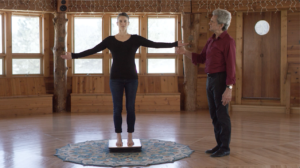By Nancy Eichhorn Ph.D.
Gravity matters. Not simply to keep us physically grounded here on Earth, but, at a fundamental level, our relationship with gravity affects our lives from start to finish.
We start life floating in amniotic fluids. It’s easy to assume a sense of buoyancy, free from gravity’s impact. Yet, gravity is necessary for our physiological development during the second half of our lives in the womb (Sekulic’, Lukac, and Naumovic, 2005).
We sense gravity’s force from birth forward as we experience our verticality. Standing upright, we learn to manage the polarity of motion and stability. As primary resources develop, such as grounding, balancing, orienting, centering, and more, we build the capacity to orient to the space around us.
According to Darrell Sanchez Ph.D., “Our verticality relates to our sense of security. The ability to orient vertically to our environment enables us to see the full 360 degrees of our surroundings to identify and distinguish between threat and safety, to determine if we should approach or avoid a situation. Successful orienting from functional verticality combines our internal proprioception system with the perception of information from the environment. Well-being and confidence follow from this success as we connect to a more profound, fuller sense of ourselves” (Sanchez & Gettliffe, 2016).
“Connection to our bodies, centering, myofascial responsiveness, and our capacity to experience the space within and around us contribute to a balanced and oriented embodiment. When we are internally aware and attuned to the environment, we know where we are in the present moment, an essential step toward knowing who we are” (Sanchez & Gettliffe, 2016).
When we are out of balance in our lives and our bodies, we may notice changes in our physical, emotional, psychological, and spiritual well-being. Sanchez has explored vertical integration, verticality, and vertical embodiment resources concerning psychological aspects of our experience. He asserts that vertical integration of the whole body within the field of gravity is associated with improvements in our quality of life. To develop and or support vertical embodiment resources, he created the Tuning Board.
Per Sanchez, The Tuning Board is a somatic movement tool that gently stimulates the nervous system at the deepest levels of the brain and spinal cord. The flow of movement stimulation through our vertical human postures carries information between the brain, the body, and the environment.
That movement stimulates the brainstem and the vagus nerve complex on its journey. The soft acceleration and amplification of the natural flow of movement on the Tuning Board make the flow of energy and information present from moment to moment. Fostering a nonjudgmental awareness makes it an exceptional tool for mindfulness movement. The constant movement provides a gentle stimulation of the vagus and visceral sensory organs and the balance and proprioception functions of the vestibular organs, cerebellum, and cortical regions of the brain (Sanchez, personal communication, April 30, 2022).
“The information shows us who we are, what we think, feel, imagine, and what we have experienced. The waves of motion that course through the vertical nervous system in the dance with gravity activate inhibition and recovery of the ventral vagal complex that ‘ . . . provides an anatomical basis for historical concepts of the optimal balance among physiological systems . . .’” (Sanchez, personal communication, April 30, 2022).
Sanchez explained that somatic therapists can use the Tuning Board to encourage this felt experience of fluid verticality directly influencing the vagus nerve complex. Once they have experienced the Tuning Board for themselves and reviewed available online information (www.tuningboard.org/somatictherapy) and brief videos (an overview video and video on introducing the Tuning Board to your client), they can begin using it with clients. Simply assisting the client to stand safely on the Tuning Board in a neutral position is already impactful; the Tuning Board and the client’s nervous system will do the rest.
Darrell is offering a free question and answer session on June 3, 2022. For information, please visit: www.tuningboard.org/trainings/#June3
SPT Magazine readers receive a 10% discount on the purchase of a Tuning Board. Our discount code is: SPT2022
To download the PDF of the article, please click here
Please visit www.tuningboard.org/trainings for general information.
Darrell Sanchez, Ph.D., is a licensed professional counselor, trauma therapist, certified advanced Rolfer™, and a movement/therapy/dance instructor.
References
Porges, S. W. (2021). Polyvagal Safety: Attachment, Communication, Self-Regulation. New York: W. W. Norton & Company.
Sanchez, D. & Gettliffe, V. (2016). Dancing with gravity: using the Tuning Board to promote vertical embodiment resources and vertical integration. ISAI Yearbook of Structural Integration.
Retrieved from https://static1.squarespace.com/static/5ade403a2487fde83756c638/t/5c954b71a4222f9b0a580d15/1553288055363/IASIDancingwithGravity.pdf
Sekulic, S. R., Lukac, D. D., & Naumovic, N. M. (2005). The fetus cannot exercise like an astronaut: Gravity loading is necessary for the physiological development during the second half of pregnancy. Journal Medical Hypotheses 64(2): 221-8. doi: 10.1016/j.mehy.2004.08.012. Retrieved from https://pubmed.ncbi.nlm.nih.gov/15607544/
Photo Credits:
Woman in gravity: by Meric Tuna on Unsplash
Darrell Sanchez: Darrell Sanchez
Woman on Tuning Board: Darrell Sanchez










